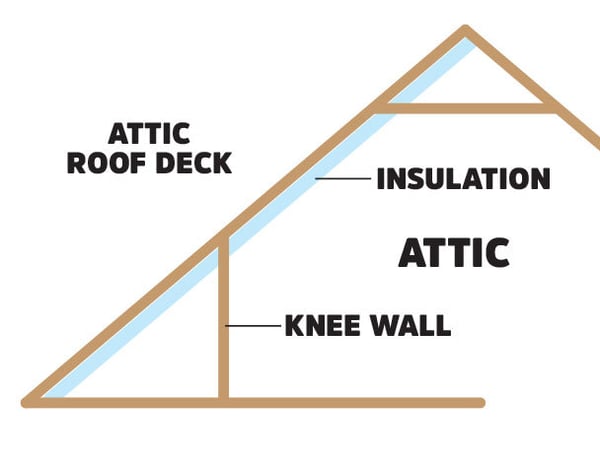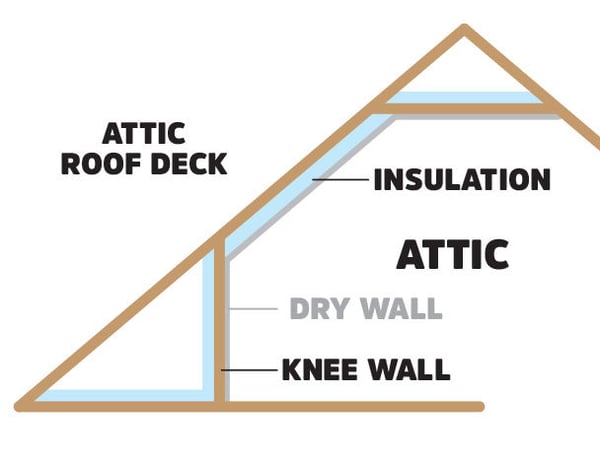How to Properly Insulate a One and a Half Story House


Do you feel the pain of living in a poorly insulated one-and-a-half-story house?
I’ve talked with many homeowners that do. In fact, I just spoke with a homeowner of a one and a half story home who told me his upstairs is nearly 30-degrees warmer than the rest of the house in the summer.
Wow.
As a project manager for RetroFoam of Michigan, I’ve personally visited more than 1,050 homes across Michigan over the past few years. My job is to help homeowners find the best solutions to their uncomfortable homes, high energy bills, or other insulation-related challenges.
From all my experience the one and a half story home have really stuck out to me. These homes are architecturally beautiful and have their benefits, but they are also plagued by some of the worst insulation problems you could ever imagine.
In this article, I want to address the reason behind the comfort challenges of one-and-a-half-story homes and what can be done to transform them into the cozy home your family deserves.
But first, let’s make sure we are on the same page when talking about a one-and-a-half-story house.
What is a One and a Half Story House?
In a one and a half story house, the upper level does not have the standard eight-foot walls around the perimeter.
Rather, the walls are sloped, or they have shorter knee walls, as well as dormers or windows in the gable ends. The floor plans of the living space between the ceiling of the first story and the roof are typically used for bedrooms or a common loft area.
Disadvantages of a One and a Half Story House
There are some things that are appealing about the floor plans of a one-and-a-half-story house.
For example, having kids I can see how it would be nice to have a first-floor master bedroom and additional bedrooms upstairs. However, this style of home doesn’t come without some major disadvantages.
From my experience, nearly every one of the homes designed this way I visit has major insulation problems. The upstairs is always way colder or warmer than the rest of the house depending on the season - so much so that the upstairs rooms might only be able to be used seasonally.
In the home I mentioned above, in the winter it gets so cold upstairs that it forces their son to sleep on the downstairs couch. This is miserable for the entire family.
The Cause of the Upstairs Insulation Problems
The unique design of a one-and-a-half-story home calls for it to be insulated a certain way to ensure the home is comfortable and energy-efficient.
More specifically, the roof slant and knee walls are the two main areas where I see the most insulation problems.
In both of these places, it is typical to find fiberglass or cellulose insulation. At the end of the day, these traditional insulation materials don’t provide an air seal so the outside air will still find its way in and the inside air will still find its way out.
This is especially noticeable where the drywall meets the stud trusses on the slanted part of the roof since there is typically a thin layer of fiberglass stuffed into the cavity. Little R-Value with no air seal along the roof allows no way to obtain the proper insulation requirements and is a recipe for major comfort issues.
Since it is difficult for a homeowner to try to fix the insulation on the slope, they often try a variety of things with the knee walls or the access door.
I commonly see people move their dressers in front of the access door to try to stop the outside air from coming in, as well as add more fiberglass or cellulose to the cubby space.
In one home I visited, I opened up the cubby access door to see the entire space filled to the top with cellulose. However, these hacks won’t solve the problem because it isn’t blocking the airflow.
How to Insulate a One and a Half Story House
After a homeowner runs out of DIY options that’s when I come into the picture. They give RetroFoam of Michigan a call to see if we can help.
Spray foam insulation is a perfect solution to solve these extreme comfort issues as it completely seals the envelope of the home, unlike the current traditional insulation.
Unless the upstairs is gutted many insulation contractors won’t entertain this kind of work since it can be difficult and obtrusive. Our crews have had great success with tricky installs and here are a few ways they’d tackle the upstairs of a one and a half story home.
If there is access and enough room to get up in the top attic space then we’ll be able to access the slant areas from there. Using a special tool we’ll be able to hook on to the fiberglass in the slants to remove it then spray the slant areas from the top attic and also from the cubby area.
If there are scissor trusses or we can’t get up in the top attic space, then the only other option is to cut strips in the slant to remove the old insulation then spray the foam in. This is similar to how we’d insulate an existing cathedral ceiling.
 The best-case scenario is that the roof deck or the underside of the roof is insulated with spray foam. This seals off the entire upstairs and fully keeps the inside air in and outside air out, as it should be. This will also allow you to take full advantage of the cubby space for storage and that area will be the same temperature as the rest of the upstairs.
The best-case scenario is that the roof deck or the underside of the roof is insulated with spray foam. This seals off the entire upstairs and fully keeps the inside air in and outside air out, as it should be. This will also allow you to take full advantage of the cubby space for storage and that area will be the same temperature as the rest of the upstairs.
In certain situations, like if the upstairs is above an uninsulated garage, it may make sense to insulate the knee wall instead of the entire roof deck.
 In this scenario, we’d insulate the first-floor ceiling in the cubby area, up the knee wall, and then the slope up the roofline, and finally the second-floor ceiling. Under this method, you will still need vents in the cubby area and won’t be able to fully take advantage of that storage space.
In this scenario, we’d insulate the first-floor ceiling in the cubby area, up the knee wall, and then the slope up the roofline, and finally the second-floor ceiling. Under this method, you will still need vents in the cubby area and won’t be able to fully take advantage of that storage space.
Fixing the Comfort Issues in Your One and a Half Story Home
Many homeowners have no idea what they are getting into when they buy a one-and-a-half-story home.
The homeowners I’ve met with are so happy to realize there is a solution to help their homes become comfortable. To learn more about the possibility of foam insulation in your home, check out more of our educational resources today.
Related Articles
What is the Best Attic Insulation? (Spray Foam vs Fiberglass vs Cellulose)

